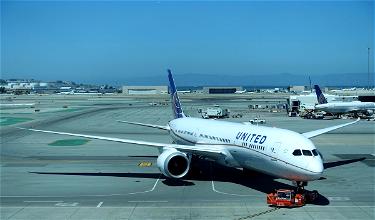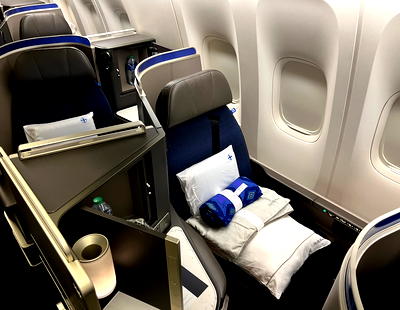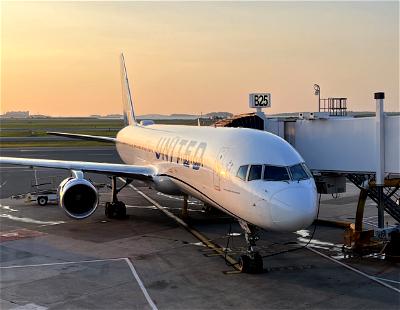There’s a story that has gone viral regarding United’s October 2 flight from Los Angeles to Sydney, UA839, which landed early this morning (October 4). The pilot declared a “mayday,” which is a distress signal generally used for life-threatening emergencies (less urgent situations will receive a “pan” call).
I’ve seen a lot about this in US media, but it seems that this story went even more viral in Australia, where it has made national headlines. For example, check out this news clip in Australia, which comes across as rather sensationalized. They even interview a passenger who just got off the flight to get their take on it (even though they had no clue there was any sort of an emergency).
So, what do we know about this situation? The total flight time was 14hr5min, which is no longer than usual. The flight wasn’t even full. A 787-9 has the range to fly much longer than that. For example, this is the same plane that United has used to operate their flight from Los Angeles to Singapore, which is a couple of hours longer.
Here’s the ATC audio of some of the “incident:”
So this raises a few logical questions:
Why didn’t the United plane have more fuel?
Generally speaking airlines will only load as much fuel as they have to, which would be the projected fuel burn plus minimal reserves, plus a small additional buffer. Ultimately the reason they don’t always load a couple of hours of extra fuel is because it adds weight to the plane. In other words, you’ll burn more fuel just to carry the extra fuel, not to mention it may come at the cost of carrying cargo.
So it’s also possible that a 787 operating a four hour flight could have a fuel emergency, since it won’t have a 10+ hour reserve of fuel.
What caused this fuel emergency?
We don’t actually know for sure yet. Just because the flight wasn’t longer than usual doesn’t mean they didn’t burn more fuel than usual. It could have been that headwinds were stronger than expected, or that they didn’t fly at an ideal altitude.
Interestingly in a statement to Australian media, United Airlines indicated that there was a “mechanical issue” with the plane. That wasn’t communicated to air traffic control, which makes me wonder if that’s actually the case, or if that’s something they said after the fact when they realized they may have more fuel than they were expecting, and they wanted to avoid any issues with an investigation (lying about a mayday is a serious problem).
How little fuel did the plane actually have?
Based on the degree to which this story is being sensationalized, you’d think the plane had a few gallons of fuel left and was in serious danger.
Looking at the Australian Government Civil Aviation Safety Authority guidelines, here’s what it says about mayday fuel declarations:
EMERGENCY FUEL – is a situation of fuel emergency when the calculated usable fuel predicted to be available upon landing at the nearest aerodrome where a safe landing can be made is less than the fixed fuel reserve and as a result of this predicted fuel state, the aircraft requires immediate assistance.
Note: MAYDAY FUEL DECLARATION is a distress message indicating the pilot-in-command has assessed that the aircraft is threatened with grave and imminent danger and requires immediate assistance.
To further define that, here’s what the fixed fuel reserve is:
FIXED FUEL RESERVE – the amount of fuel, expressed as a period of time, required to fly at holding speed at 1,500 feet above aerodrome elevation at ISA conditions, calculated with the estimated weight on arrival at the destination alternate aerodrome, or the destination aerodrome when no destination alternate aerodrome is required, that would be useable fuel remaining in the fuel tanks until completion of the final landing.
Based on the chart further down in the same document, the fixed fuel reserve for a jet would need to be 30 minutes.
So based on that, a mayday could be called if the plane was expecting to have less than a 30 minute fuel reserve when landing. Again, even with a roughly 30 minute reserve, the plane would still have enough fuel to do another approach in the event of a missed approach.
It’s perfectly normal for planes to land with 31-60 minutes of fuel, so if they had a little more fuel we probably wouldn’t have heard about this issue.
Did the airport overreact?
Sydney Airport shut down the roads around the airport when this incident occurred. Was that an overreaction for an event like this, where a plane was making a routine landing? Yes, probably.
At the same time, a lot of situations like this are based around consistent protocols. In other words, when a plane calls a mayday the airport likely responds in the same way, regardless of whether this is a low fuel situation, or a plane with an engine that fell off.
So while that was probably unnecessary here, better safe than sorry, I guess, as there’s value in having consistent protocols.
Bottom line
The reason air travel is so safe is because of all the precautions that are taken. We have no reason to believe that anyone’s life was in danger, as the plane almost certainly had enough fuel to make another approach. The plane was more likely to just be slightly below minimums.
What we don’t know is why the plane burned fuel more quickly than expected. It could have been due to unfavorable winds, or an unfavorable cruising altitude. United also indicated there may have been a mechanical (which wasn’t communicated to air traffic control), though I find that a bit odd.
Regardless, there really isn’t much to see here, even if the airport was super cautious in closing off the roads (presumably in preparation for a runway overrun/crash landing).
As to why airlines don’t load more fuel, it’s both a cost saving and environmental thing. Airlines are pretty good at predicting fuel burn nowadays, and it’s rare that this becomes a major problem.
What do you make of this United incident in Sydney?





And happened Friday 24 on UA839. Divert to CBR as low fuel after short holding pattern outside SYD.
It seems airlines generally have minimum legal amount of fuel loaded and UA cuts it very fine.
Ben,
It just happened again with United UA101 (16-Jan-2020). However, this time they were so low on fuel they diverted to New Zealand Auckland airport where passengers had to disembark for 10 hours. United also changed the aircraft, pilots, and crew!
I flew UA Melbourne to LAX, and watched the very bright blue Paciifc Ocean almost all the time on the flight monitor. These are NOT flights you'd choose for running out of fuel. Give me NYC to LAX instead, please!
@Nick, pilots do not call the tower on the phone. All is done on recorded frequencies only, so as to have it all "on tape" in case of a lawsuit.
Lucky, remember UAL flies under FAA regulations for flight planning/fuel requirements. The other unknown is what their op specs says and what exemptions they may have as well. This whole story is way more complicated than everyone realizes
-FAA licensed dispatcher
@K. #findanotherblogbitch
Can anyone clarify why this flight didn’t divert to Brisbane which is enroute and some 50 minutes shorter flight time? Running fuel reserves down to a Mayday trigger level suggests United Operations made the call in the interests of scheduling (aka profits).
@Lucky
It's "Pan-pan" not "Pan". There's also "Securité", which is a lower urgency call, IIRC.
It's not nothing. A fuel mayday is highly unusual for a competent airline, crew and airframe. If Aniljak is correct, that is reassuring. But regardless of weather somebody f'd up. Winds aloft on this route are hardly a secret. To say there is nothing to see here is completely ludicrous and devalues your commentary.
I am pretty sure if it was a serious emergency the aircraft would be going direct, not via the STAR. STARs or Standard Terminal Arrivals are used to separate traffic and incorporate heading, altitude and airspeed restrictions. In a serious fuel emergency they would be traveling direct to the airport to minimize time in the air.
This has been all over the press and TV in Australia, they love a good drama. Shutting down the roads around the airport just because the pilot had a hot date and needed to land immediately, love it.
Aniljak, you may be ex ATC, but UA839 is a LAX-SYD service, it doesn't originate in SFO.
SFO-SYD is UA863, which landed on runway 16L.
For sure it's a beat-up by the media ( a quiet October Thursday in the break between football and cricket seasons, parliament not in session, no other dramas). So of course they will go for it.
As for the reaction, I prefer that authorities take the mayday declaration seriously, including closing of roads around the airport. Better that than ending up with something like the Avianca crash in New York ( ran out of...
For sure it's a beat-up by the media ( a quiet October Thursday in the break between football and cricket seasons, parliament not in session, no other dramas). So of course they will go for it.
As for the reaction, I prefer that authorities take the mayday declaration seriously, including closing of roads around the airport. Better that than ending up with something like the Avianca crash in New York ( ran out of fuel and crashed into the river during confusion in discussions with ATC over fuel levels, priority landing, emergency or not; most died in the crash).
It’s been all over the local news down here in Sydney, but not many facts have been reported
I am ex Australian air traffic control so have som knowledge.
It was UA839 from San Francisco not Los Angeles.
Sydney had major storms that were heavier than forecast and aircraft had stronger than forecast headwinds for last couple of hours.
Required to have 45minutes reserve fuel on landing or declare emergency which aircraft did. When landed had 39 minutes.
Pilots had been recalculating regularly and when figure got close to 45 min requirement acted...
I am ex Australian air traffic control so have som knowledge.
It was UA839 from San Francisco not Los Angeles.
Sydney had major storms that were heavier than forecast and aircraft had stronger than forecast headwinds for last couple of hours.
Required to have 45minutes reserve fuel on landing or declare emergency which aircraft did. When landed had 39 minutes.
Pilots had been recalculating regularly and when figure got close to 45 min requirement acted accordingly. ATC and airport went with standard emergency procedures as safety comes first. It s why Australia is a leader in Aviation safety. Airport closed roads arounnd for less than 5 minutes. Very little affect on operations
Suggesting United are lying to the media in an attempt to distract investigators from the reason for the low fuel is absolutely absurd.
It's also rather insulting to the investigators - you REALLY think the main focus of their investigation will be looking at United media statements and blindly accepting anything inside them?
This making the news also doesn't mean it's "gone viral". It hasn't gone viral, it's just been reported on.
It was a United Airlines plane. I would not put anything past them. They lie to their passengers repeatedly on the ground, why not in the air, too?
I’m pretty sure it was UA839 for starters.
And my educated guess is there was a change in the TAF between departure and arrival and the flight was now no longer carrying the ‘new’ minimum required fuel.
It’s incumbent on the airline to divert and uplift the new required fuel (inter or tempo requirement, perhaps some additional traffic holding on top of that) - but this can create additional problems (crew hours, missed connections,...
I’m pretty sure it was UA839 for starters.
And my educated guess is there was a change in the TAF between departure and arrival and the flight was now no longer carrying the ‘new’ minimum required fuel.
It’s incumbent on the airline to divert and uplift the new required fuel (inter or tempo requirement, perhaps some additional traffic holding on top of that) - but this can create additional problems (crew hours, missed connections, downline dealys - outbound crew may have already been at SYD)
Perhaps there WAS an engineering issue that had they landed elsewhere they couldn’t have redeparted so coupled with being below the new min fuel requirement a MAYDAY was declared.
I know of no pilot in the world who would declare a MAYDAY out of convenience only - so i would say a number of factors have contributed here.
Sydney Airport would most likely of made a fortune out of billing United for the situation hence the possible big reaction but when it comes to human safety there should be no shortcuts taken. All procedures must be followed, too much at stake... Lives, careers, equipment, money... lol. Plus the Australian media love bashing airlines (fact)
Michael says:
October 4, 2018 at 2:34 pm
AA 73, also a B787-9 flying from LAX to SYD on October 2nd, diverted to HNL when it was approximately 800nm SSE of the Hawaiian Islands.
This was reported as a Medical diversion, nothing to do with fuel issues.
It is useful to keep in mind that the audio you hear on ATC isn't the only communication that pilots and the tower have with each other and with "company" (literally their company, in this case United). It is likely the pilots were on the phone with United mechanics and that the information they figured out may have been communicated with the tower via phone.
"also worth noting that there may have been more of a mechanical issue here as they delayed the following traffic in so they could inspect the runway expecting “a leak of gas” see 3:50 into the video"
The controller clearly says "I just need to leave a bit of gap" at 3:54. The transcript is wrong
A plan needs to have enough fuel at takeoff to reach its alternate airport (if original not available) plus 30-45 minutes. All required in case communications breakdown and the pilot can't communicate with control.
And did anyone listen to the tape? Controller said it was leaking fuel and the runway would need to be checked.
Just going to leave this here
https://www.youtube.com/watch?v=GW_42xmcsBU
Needs better clickbaity title
AA 73, also a B787-9 flying from LAX to SYD on October 2nd, diverted to HNL when it was approximately 800nm SSE of the Hawaiian Islands.
The plane probably had slightly more drag than normal due to a mechanical issue but not enough of a problem to trip a sensor. United has no idea what happened until they look at the plane and may have claimed mechanical as a default since it covers nearly every issue that would cause this
All that matters is the airline saves/makes money
If they lose a plane full of passenger no big deal
There are many others that don't fall out of the sky
Sorry, I'm chuckling at the typo under "Why didn't the plane have more fuel." A380s must gorge at a buffet. 787s nibble on tapas. I think you meant buffer, but in context, buffet is almost correct.
also worth noting that there may have been more of a mechanical issue here as they delayed the following traffic in so they could inspect the runway expecting "a leak of gas" see 3:50 into the video
Lucky says:
"Generally speaking airlines will only load as much fuel as they have to, which would be the projected fuel burn plus minimal reserves, plus a small additional buffet."
I not sure how a small buffet -- no doubt intended for the Polaris passengers -- helps with the fuel. I think you meant to say buffer. Usually I don't pay attention to typos but I couldn't resist pointing out this one
I love it when airlines load a small additional buffet, makes for a really yummy flight!
Australia has a nanny state culture, hence the roads shutdown
You’re over sensationalizing it as well. But, that’s normal for this blog these days.
The Australian mainstream media love beating up any aviation dramas.
Anytime a Qantas plane diverts (even for a medical emergency), it's headline news.
It also could have left with less than the required fuel.